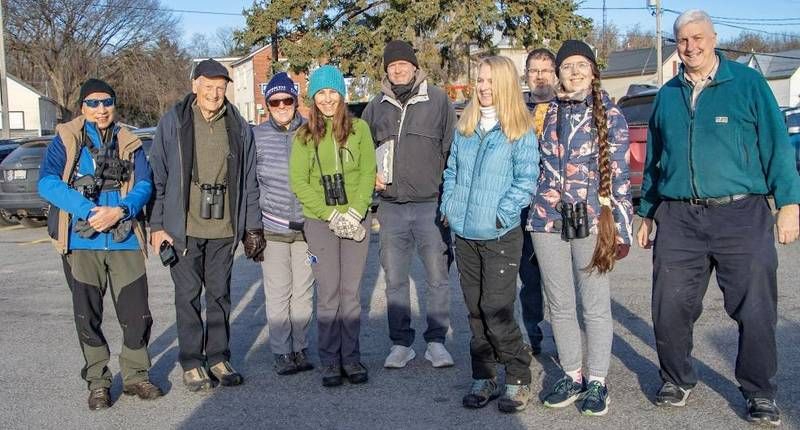Submitted by Carolyn Bonta | Jan 10, 2024
For the first time in nine years, temperatures were mild (if not downright warm) and sunny for count day on Saturday, December 16, 2023. With no snow to obstruct travel, a field crew of 41 surveyors was able to cover a lot of ground, including 92 km by foot on backroad and trail – after all, the best way to find birds is to get out of the car, look, and listen.
Together with the efforts of 7 feeder-watchers, we tallied 3,737 individuals from 55 species. Wintergreen Studios opened their bird count to the public as an interpretive event, introducing an additional 10 participants to the Frontenac CBC
2023 Frontenac CBC Summary
Abundant open water translated into huge numbers of waterfowl and gulls, as well as a diversity of water associated species such as Common Loon, Great-blue Heron, Belted Kingfisher, Red-winged Blackbird and lots of Bald Eagles. Common Mergansers handily grabbed top spot as the most abundant species observed on count day. Coming in a distant second, Canada Goose numbers were surprisingly low compared with previous years with similarly open water. White-breasted Nuthatches were very abundant, in contrast to their migratory Red-breasted counterpart. Starling numbers remain high, but Rock Pigeon and House Sparrow have almost disappeared.
More Brown Creepers were seen this year than in the past. Wild Turkeys were scarce, as were the LBJ (“little brown job”) sparrows. Two teams were surprised at the absence of Ruffed Grouse in otherwise ideal habitat. One of these surveyors, in chatting with neighbours, learned that others had not seen grouse recently, either.
Two parties included a nocturnal component to their survey, one of which successfully detected two Great-horned Owls. The Frontenac CBC circle list held steady at 85 species, as no new species were added during this year’s census or during Count Week.
More than just a bird count
Sure, we’re looking for birds – but we notice more than birds. This year, surveyors’ heads were turned by two “not-birds”: a raven-shaped trash bag and a broken branch with an uncanny resemblance to a shrike. We learned about local geology [page 5]. On the trails of Frontenac Park, one team didn’t expect to cross paths with a Gartersnake, while another team put equal effort into identifying both birds and fungi, at one point engaging in a lively “is it a dog stinkhorn or something else?” debate. And the Wintergreen group was charmed by “a very cute porcupine napping in a tree”.
We typically think of woodpeckers obtaining food by, well, pecking wood. Yet, a Pileated Woodpecker was seen delicately eating berries.
Wrap-up Results from the 2023 Frontenac CBC have been submitted to the National Audubon Society.
A stellar job once again by everyone involved! Our 10th Anniversary is fast approaching, and we want to make it the best count in ten years. Round up family, friends, and neighbours to join the fun next year on Saturday, December 14, 2024. There will be something for everyone’s birding ability and outdoor interests. After 123 years, Christmas Bird Counts remain the longest-running Citizen Science project in North America. Thank you for your help in contributing valuable data on winter bird populations.
As we plan for the Frontenac CBC’s 10-year Anniversary in 2024, we could use some extra hands to make next year’s CBC experience a special one. Do you have ideas? Can you help? Michael and Carolyn would love to hear from you! This email address is being protected from spambots. You need JavaScript enabled to view it.
More Stories
- Wildfire in the 1000 block of Rutledge Road - Township Says Fire Now "Under Control"
- Verona and Sydenham Ballpayers Win National Championship With Kingston Colts
- Sweet Music and Some hard Truths At Blue Skies MusicFestival
- Building a Medical Service in Sharbot Lake
- The Local Brewing Scene – Kick and Push Continues to Grow
- Parham Fair Celebrates 133 Years Ion Spite of Setback
- Seventh Town to play Sharbot Lake As Part of Mini-Tour
- Repair Plan For Micro-Fit In North Frontenac
- September Closures for Northbrook And Sharbot Lake Beer Stores
- This "Doc Is Not In Anymore" After 54 Years

